 W
WThe history of Poland from 1939 to 1945 encompasses primarily the period from the invasion of Poland by Nazi Germany and the Soviet Union to the end of World War II. Following the German–Soviet non-aggression pact, Poland was invaded by Nazi Germany on 1 September 1939 and by the Soviet Union on 17 September. The campaigns ended in early October with Germany and the Soviet Union dividing and annexing the whole of Poland. After the Axis attack on the Soviet Union in the summer of 1941, the entirety of Poland was occupied by Germany, which proceeded to advance its racial and genocidal policies across Poland. Under the two occupations, Polish citizens suffered enormous human and material losses. According to the Institute of National Remembrance estimates, about 5.6 million Polish citizens died as a result of the German occupation and about 150,000 died as a result of the Soviet occupation. The Jews were singled out by the Germans for a quick and total annihilation and about 90 percent of Polish Jews were murdered as part of the Holocaust. Jews, Poles, Romani people and prisoners of many other ethnicities were killed en masse at Nazi extermination camps, such as Auschwitz, Treblinka and Sobibór. Ethnic Poles were subjected to both Nazi German and Soviet persecution. The Germans killed an estimated two million ethnic Poles. They had future plans to turn the remaining majority of Poles into slave labor and annihilate those perceived as "undesirable" as part of the wider Generalplan Ost. Ethnic cleansing and massacres of Poles and to a lesser extent Ukrainians were perpetrated in western Ukraine from 1943. The Poles were murdered by Ukrainian nationalists.
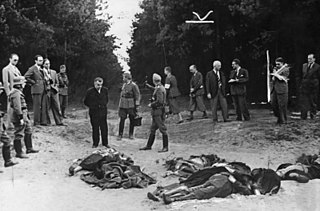 W
WBloody Sunday was a sequence of violent events that took place in Bydgoszcz, a Polish city with a sizable German minority, between 3 and 4 September 1939, during the German invasion of Poland.
 W
WThe bombing of Wieluń is considered by many to be the first major act of World War II, and the September Campaign. After Luftwaffe air units moved into Polish airspace in the early morning of 1 September, they reached the town of Wieluń by 04:40–45 hours. Around this time, the first strikes on the town were conducted, with a total of 46,000 kg bombs being dropped on civilian targets for 9 consecutive hours. Elsewhere, the Battle of Westerplatte and Danzig skirmishes began around the same time, starting the well-coordinated Invasion of Poland.
 W
WThe Ciepielów massacre that took place on 8 September 1939 was one of the largest and best documented war crimes of the Wehrmacht during its invasion of Poland. On that day, the forest near Ciepielów was the site of a mass murder of Polish prisoners of war from the Polish Upper Silesian 74th Infantry Regiment. The massacre was carried out by soldiers from the German Wehrmacht 15th Motorized Infantry Regiment, 29th Motorized Infantry Division, under the command of Colonel Walter Wessel.
 W
WThe Częstochowa massacre, also known as the Bloody Monday, was committed by the German Wehrmacht forces beginning on the 4th day of World War II in the Polish city of Częstochowa, between 4 and 6 September 1939. The shootings, beatings and plunder continued for three days in more than a dozen separate locations around the city. Approximately 1,140 Polish civilians, were murdered.
 W
WElections to the People's Assemblies of Western Ukraine and Western Belorussia, which took place on October 22, 1939, were an attempt to legitimize the annexation of the Second Polish Republic by the Soviet Union following the September 17 Soviet invasion of Poland in accordance with the secret protocol of the Molotov–Ribbentrop Pact. Only one month after the eastern territories of Poland were occupied by the Red Army, the Soviet secret police and military led by the Party officials staged the local elections in an atmosphere of state terror. The referendum was rigged. The ballot envelopes were numbered and often handed over already sealed. By design, the candidates were unknown to their constituencies which were brought to the voting stations by armed militias. The results were to become the official legitimization of the Soviet takeover of what is known today as the Western Belorussia and the Western Ukraine. Consequently, both Assemblies voted for incorporation of all formerly Polish voivodeships into the Soviet Union.
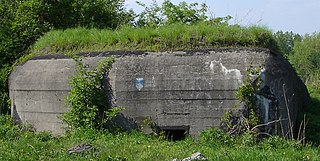 W
WThe Fortified Area of Silesia was a set of Polish fortifications, constructed along the interbellum border of Poland and Germany in the area of then-divided Upper Silesia. It spreads from the village of Przeczyce in the north to the town of Wyry in the south, along the line of sixty kilometers. Headquarters of the area was placed in Chorzów and its commandant was General Jan Jagmin-Sadowski.
 W
WThe Hel Fortified Area was a set of Polish fortifications, constructed on the Hel Peninsula in northern Poland, in close proximity to the interwar border of Poland and the Third Reich. It was created in 1936, upon a decree of President Ignacy Moscicki. It covered most part of the peninsula, and during Polish September Campaign, it was the last place of Poland to surrender to the invading Wehrmacht. During World War II, the naval base in Hel was used as a major training facility for U-boat crews.
 W
WOperation Himmler, also called Operation Konserve or Operation Canned Goods, was a 1939 false flag project planned by Nazi Germany to create the appearance of Polish aggression against Germany. That was then used by the Germans to justify their invasion of Poland.
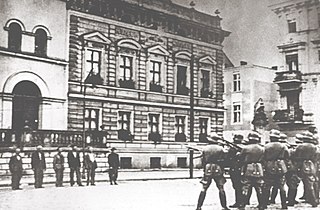 W
WThe Intelligenzaktion, or Intelligentsia mass shootings, was a mass murder conducted by Nazi Germany against the Polish intelligentsia early in the Second World War (1939–45). The operations were conducted to realise the Germanization of the western regions of occupied Poland, before territorial annexation to the German Reich.
 W
WThe Intelligenzaktion Pommern was a Nazi German operation aimed at the eradication of the Polish intelligentsia in Pomeranian Voivodeship and the surrounding areas at the beginning of World War II. It was part of a larger genocidal Intelligenzaktion, that took place across most of Nazi-occupied western Poland in the course of Operation Tannenberg, purposed to install Nazi officials from SiPo, Kripo, Gestapo and SD at the helm of a new administrative machine.
 W
WThe Invasion of Poland, also known as the September campaign, 1939 defensive war and Poland campaign, was an attack on the Republic of Poland by Nazi Germany and the Soviet Union which marked the beginning of World War II. The German invasion began on 1 September 1939, one week after the signing of the Molotov–Ribbentrop Pact between Germany and the Soviet Union, and one day after the Supreme Soviet of the Soviet Union had approved the pact. The Soviets invaded Poland on 17 September. The campaign ended on 6 October with Germany and the Soviet Union dividing and annexing the whole of Poland under the terms of the German–Soviet Frontier Treaty.
 W
WJabłonków incident refers to the events of the night of August 25/26, 1939, along the Polish-Slovak border, when a group of German Abwehr agents attacked a rail station in Mosty. The main purpose of the attack was to capture the Jablunkov Pass, with its strategic railroad tunnel, until the arrival of the German armed forces. The attackers were repelled by units of the Polish Army, and the incident is regarded as a prelude to the German invasion of Poland. The Jabłonków Incident has been named the first commando operation of the Second World War.
 W
WThe Katowice massacre or the Bloody Monday in Katowice that took place on 4 September 1939 was one of the largest war crimes of the Wehrmacht during its invasion of Poland. On that day German Wehrmacht soldiers aided by the Freikorps militia executed about 80 of the Polish defenders of the city. Those defenders were self-defense militia volunteers, including former Silesian Insurgents, Polish Boy and Girl Scouts, and possibly a number of Polish soldier stragglers from retreating Polish regular forces who joined the militia.
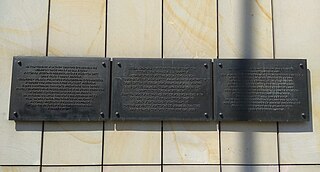 W
WThe Lipowa 7 camp was a Nazi forced labor concentration camp, primarily for Jews, by Lipowa Street in Lublin, Poland during December 1939 - 1944. In November 1943 nearly all Jewish inmates were exterminated.
 W
WThe Lublin airfield camp was a Nazi forced labor concentration camp, primarily for Jews, at the airfield in Lublin, Poland during 1942–1943, with its prehistory starting from 1939. It also employed and detained (non-Jewish) Polish women. It is also referred to as "(Lublin) airstrip camp", "Flugplatz labor camp", "Alter Flugplatz lager", etc.
 W
WThe massacres in Piaśnica were a set of mass executions carried out by Nazi Germany during World War II, between the fall of 1939 and spring of 1940 in Piaśnica Wielka in the Darzlubska Wilderness near Wejherowo. The exact number of people murdered is unknown, but estimates range between 12,000 and 14,000 victims. Most of them were Polish intellectuals from Gdańsk Pomerania, but Poles, Jews, Czechs and German inmates from mental hospitals from the General Government and the Third Reich were also murdered. After the Stutthof concentration camp, Piaśnica was the largest site of killings of Polish civilians in Pomerania by the Germans, and for this reason, is sometimes referred to as the "second" or "Pomeranian" Katyn. It was the first large scale Nazi atrocity in occupied Poland.
 W
WThe German–Soviet military parade in Brest-Litovsk was an official ceremony held by the troops of Nazi Germany and the Soviet Union on September 22, 1939, during the invasion of Poland in the city of Brest-Litovsk. It marked the withdrawal of German troops to the demarcation line secretly agreed to in the Molotov–Ribbentrop Pact, and the handover of the city and its fortress to the Soviet Red Army.
 W
WOperation Tannenberg was a codename for one of the anti-Polish extermination actions by Nazi Germany that were directed at the Poles during the opening stages of World War II in Europe, as part of the Generalplan Ost for the German colonization of the East. The shootings were conducted with the use of a proscription list, compiled by the Gestapo in the span of two years before the 1939 invasion.
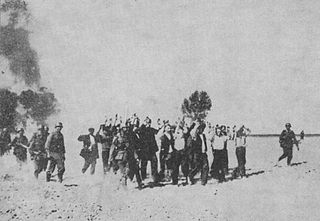 W
WThe pacification actions in German-occupied Poland during World War II were one of many punitive measures designed to inflict terror on the civilian population of local villages and towns with the use of military and police force. They were an integral part of the war of aggression against the Polish nation waged by Nazi Germany since September 1, 1939. The projected goal of pacification operations was to prevent and suppress the Polish resistance movement in World War II nevertheless, among the victims were children as young as 1.5 years old, women, fathers attempting to save their families, farmers rushing to rescue livestock from burning buildings, patients, victims already wounded, and hostages of many ethnicities including Poles and Jews.
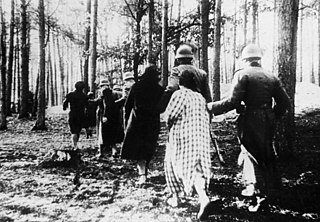 W
WThe Palmiry massacre was a series of mass executions carried out by Nazi German forces, during World War II, near the village of Palmiry in the Kampinos Forest northwest of Warsaw.
 W
WThe Peking Plan was an operation in which three destroyers of the Polish Navy, the Burza ("Storm"), Błyskawica ("Lightning"), and Grom ("Thunder"), were evacuated to the United Kingdom in late August and early September 1939. They were ordered to travel to British ports and assist the British Royal Navy in the event of a war with Nazi Germany. The plan was successful and allowed the ships to avoid certain destruction or capture in the German invasion.
 W
WIn the summer of 1939, weeks ahead of the Nazi German and Soviet invasion of Poland the map of both Europe and Poland looked very different from today. The railway network of interwar Poland had little in common with the postwar reality of dramatically changing borders and political domination of the Soviet-style communism, as well as the pre-independence German, Austrian and Russian networks which the Second Polish Republic had partially inherited in 1918 after the end of World War I. The most important junctions in the Polish territory in summer of 1939 were:
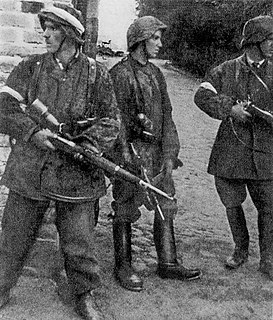 W
WSłużba Zwycięstwu Polski was the first Polish resistance movement in World War II. It was created by the order of general Juliusz Rómmel on 27 September 1939, when the siege of Warsaw, capital of Poland, where Rómmel commanded Polish defence, was nearing its end.
 W
WThe Skidel Revolt or Skidal Uprising was an anti-state and anti-Polish sabotage action perpetrated by the Jewish and Belarusian inhabitants of the Polish town of Skidel near Nowogródek at the onset of World War II. It started on the second day of the Soviet invasion of Poland in an attempt to assist the external attack.
 W
WThe Slovak invasion of Poland occurred during Nazi Germany's invasion of Poland in September 1939. The recently-created Slovak Republic joined the attack, and Field Army Bernolák contributed over 50,000 soldiers in three divisions. Since most of the Polish forces were engaged with the German armies, which were more to the north of the southern border, the Slovak invasion met only weak resistance and suffered minimal losses.
 W
WSonderaktion Krakau was the supposed codename for a German operation against professors and academics of the Jagiellonian University and other universities in German-occupied Kraków, Poland, at the beginning of World War II. It was carried out as part of the much broader action plan, the Intelligenzaktion, to eradicate the Polish intellectual elite especially in those centres that were intended by the Germans to become culturally German.
 W
WThe Battle of Tuchola Forest was one of the first battles of World War II, during the 1939 invasion of Poland. The battle began 1 September and ended 5 September with a major German victory. Thanks to poor Polish command and control, as well as German numerical and tactical superiority, the Germans managed to cripple Poland's Army Pomerania and, by breaking through the Polish Corridor, to connect mainland Germany with East Prussia.
 W
WValley of Death in Fordon, Bydgoszcz, northern Poland, is a site of Nazi German mass murder committed at the beginning of World War II and a mass grave of 1,200 – 1,400 Poles and Jews murdered in October and November 1939 by the local German Selbstschutz and the Gestapo. The murders were a part of Intelligenzaktion in Pomerania, a Nazi action aimed at the elimination of the Polish intelligentsia in Reichsgau Danzig-West Prussia, which included the former Pomeranian Voivodeship. It was part of a larger genocidal action that took place in all German occupied Poland, code-named Operation Tannenberg.
 W
WThe Wawer massacre refers to the execution of 107 Polish civilians on the night of 26 to 27 December 1939 by the Nazi German occupiers of Wawer, Poland. The execution was a response to the deaths of two German NCOs. 120 people were arrested and 114 were shot, of whom 7 survived.
 W
WThe Battle of Westerplatte was one of the first battles of the German invasion of Poland, marking the start of World War II in Europe.
 W
WThe Worek Plan was an operation of the Polish Navy in the first days of World War II, in which its five submarines formed a screen in order to prevent German naval forces from carrying out landings on the Polish coast, and to attack enemy ships bombarding Polish coastal fortifications, in particular the base on the Hel Peninsula.
 W
WThe history of Poland from 1939 to 1945 encompasses primarily the period from the invasion of Poland by Nazi Germany and the Soviet Union to the end of World War II. Following the German–Soviet non-aggression pact, Poland was invaded by Nazi Germany on 1 September 1939 and by the Soviet Union on 17 September. The campaigns ended in early October with Germany and the Soviet Union dividing and annexing the whole of Poland. After the Axis attack on the Soviet Union in the summer of 1941, the entirety of Poland was occupied by Germany, which proceeded to advance its racial and genocidal policies across Poland. Under the two occupations, Polish citizens suffered enormous human and material losses. According to the Institute of National Remembrance estimates, about 5.6 million Polish citizens died as a result of the German occupation and about 150,000 died as a result of the Soviet occupation. The Jews were singled out by the Germans for a quick and total annihilation and about 90 percent of Polish Jews were murdered as part of the Holocaust. Jews, Poles, Romani people and prisoners of many other ethnicities were killed en masse at Nazi extermination camps, such as Auschwitz, Treblinka and Sobibór. Ethnic Poles were subjected to both Nazi German and Soviet persecution. The Germans killed an estimated two million ethnic Poles. They had future plans to turn the remaining majority of Poles into slave labor and annihilate those perceived as "undesirable" as part of the wider Generalplan Ost. Ethnic cleansing and massacres of Poles and to a lesser extent Ukrainians were perpetrated in western Ukraine from 1943. The Poles were murdered by Ukrainian nationalists.
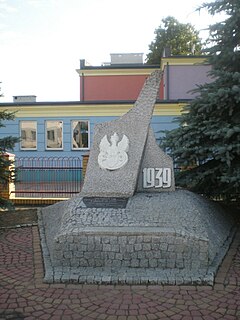 W
WThe Zambrów massacre was a war crime that took place on the night of 13–14 September 1939. It was one of the major war crimes of the Wehrmacht during the invasion of Poland. During that night, the makeshift prisoner-of-war camp in Zambrów was disturbed by a number of panicked horses, and more than 200 Polish soldiers, trying to move out of their way, were gunned down by German sentries. Some witnesses later said the horses had been purposely released into the camp by the German sentries, who used the incident as a pretext to massacre the prisoners.